
by Moe | Mar 10, 2024 | Free Will, Health, Mind Control Research, Toxic Mold
Fungi or molds are the true ouroboros of nature.
After all, fungi eat illness and death, and in doing so, create new life.

I find the concept of fungi controlling the cycle of destruction and creation highly intriguing. I often ponder the biological processes that govern these laws of nature and their filamental connections to human beings.
In my capacity as a certified mold inspector and remediator based in the United States, I am well-versed in identifying mold (fungal) infestations in homes. These infestations often manifest as a specific odor reminiscent of decaying construction materials.
Repeated exposure to this distinctive scent has honed my detection skills over the span of a decade, allowing me to identify it with almost flawless accuracy.
The other day, it occurred to me: Wouldn’t humans with fungal infections or diseases produce a similar scent of decay or rot?
A brief online investigation confirmed my hypothesis!
Many studies have shown that humans demonstrate a proficient capacity to recognize and respond suitably to scent signals indicating danger such as certain chemicals resulting from biological decay processes to evoke avoidance (Rozin et al. 2000). Researchers have found that certain volatile compounds or smell hazards can be divided into two categories based on the human emotions associated with microbial threats (e.g., organic decay, vomit or feces) and nonmicrobial hazards (e.g., predators, fire, degraded air, and poisons).
For example, the smell of smoke would elicit fear that a fire is nearby and you need to move away or flee the area, while the smell of rotting garbage or moldy drywall will cause a disgusting emotion as the person inhales these VOCs. The reason is studies have shown that each class of threats is associated with a different underlying emotion such as disgust or fear/panic, which could indicate the level of threat.
This powerful smell detection system in animals and humans serves as an evolutionary defense mechanism deeply ingrained in our subconscious minds over millennia. The scents of decay, emanating as volatile compounds, serve as environmental cues for all living beings, including microorganisms, animals, and humans.
When we inhale, these odor molecules travel through the nasal passages and reach the olfactory epithelium, where they bind to the receptor proteins. This triggers a series of chemical signals that are sent to the brain, specifically the olfactory bulb, which processes and interprets the information to identify the scent.
While some scents signal the presence of food, others indicate potential threats such as predators, pathogens, fires, or even kin relationships.
Researchers have found that many individuals have reported experiencing a distinct change in their sense of smell when they or a loved one falls ill. This phenomenon is not merely coincidental; rather, it is rooted in the intricate connections between our olfactory system and our overall health.
I know this smell all too well.
When I was a young teen serving out my community service sentence in a senior citizen home, I could vividly remember this distinct smell as I walked down the lonely concrete halls.
This smell was not pleasant. It was a mixture of urine, feces, and rotting flesh.
As I served out my 30-day sentence, I felt every time I walked into that facility that I was walking on a narrow ridge between the shadow of the valley of death and life.
The next time I came across this unique scent again was in the ICU room of a hospital when my father had almost died from alcoholism at 52.
As I watched the nurses pump the shit out of his blood as he lay there incapacitated and near death because his liver gave out, that strange smell hit my nostrils bringing back memories of the nursing home.
Again, I realized where I was.
But this time I was a visitor witnessing my father’s life being dragged into the valley of death. As if they had, the legions received a notice of his impending doom coming to feast on his barely living carcass.
Today as I look back, I’m much more educated about human biology, health, disease, and death. As it relates to the scent of death, I have found an interesting correlation that explains this phenomenon.
What I found is that scent can be a powerful indicator of understanding the science of illness and death.
THE SCIENCE OF THE SMELL OF DISEASE
Our sense of smell, also known as olfaction, is a powerful and often underappreciated sense that plays a crucial role to detect and differentiate between a vast array of scents, from the pleasant aroma of freshly baked cookies to the pungent odor of rotten eggs and even infectious diseases.
Clinicians have long recognized that most infections produce distinctive odors associated with a particular disease. In fact, each disease has a specific smell that is almost always associated with a rotten or decaying scent as if we are slowly being eaten alive, which appears to be the case.
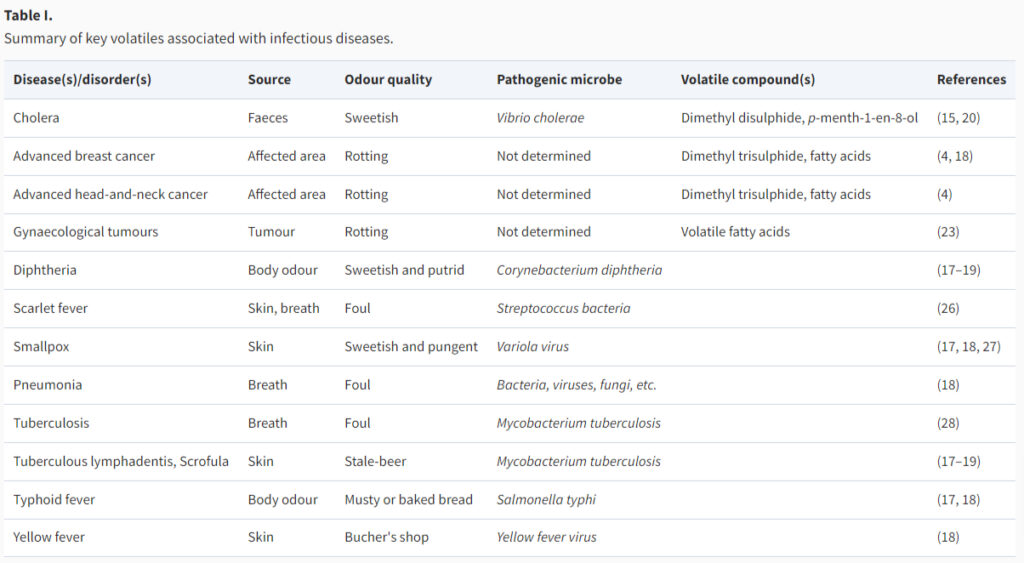
In the human body, microbial organisms generate a variety of volatile substances, and different smelly compounds like alcohols, aliphatic acids, and terpenes. Research into the emission of VOCs resulting from microbial activity in bodily fluids and organs, which are then released through breath, urine, feces, and sweat traces back to the early 1800s.
The reason is that beyond exhaling air, your breath contains volatile compounds (VOCs) originating from various bodily organs that act as environmental signals (magnets) to nearby predators, pathogens, and kin.
If we have a fungal disease in one of our organs, they will emit these VOCs through our breath, sweat, skin, urine, feces, and vaginal secretions. But our blood is the most important source for these pheromone signals in the form of bodily odors.
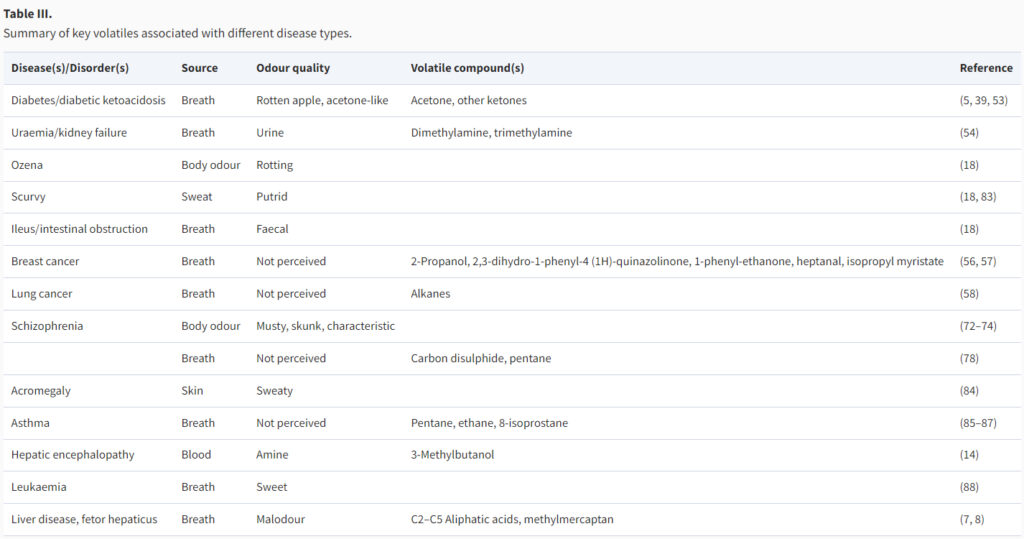
For example, it’s common to experience morning breath, particularly if you’ve slept with your mouth open. However, bad breath or halitosis can also be a sign of underlying health issues such as gum disease, respiratory infections, or even digestive problems.
Persistent bad breath that doesn’t improve with regular oral hygiene measures like brushing and mouthwash could indicate an underlying issue such as infections in the sinuses, throat, or lungs, requiring medical attention from a healthcare professional.
When we smell these odors of other people, they are called pheremones which are small volatile organic molecules that animals and humans use to communicate. Pheromones are clinically defined as “substances which are secreted to the outside by an individual and received by a second individual of the same species, in which they release a specific reaction, for example, a definite behavior or a developmental process”.
Pheromones play a critical role in signaling and choreographing interactions between fungi mating partners during sexual reproduction.
Meaning, that certain smells give off a magnetic cue for fungi within the human body that they should start having lots of sex and reproduce more offspring, which would require that the increased fungal population needs more food to feast upon.
My theory is that this increased fungal load creates fermentation within our blood and organs which morphs this symbiotic relationship into a parasitic one leading to illness, disease, and eventually death. These illnesses caused by fermentation create a unique rot or decaying odor that we have the innate ability to detect.
Interestingly, I have found that research has revealed that certain illnesses can alter a person’s body odor, making them emit distinct pheromone scents that can be detected by others, even at a subconscious level. This ability to detect sickness through pheromones may have evolved as a survival mechanism, allowing us to avoid contact with individuals who are ill and reducing the risk of spreading disease within a community.
For example, researchers have found that certain infections like tuberculosis can create a unique odor in the patient’s sweat and even metabolic disorders such as phenylketonuria can result in a musty odor in the individual’s breath or skin. A fruity or rotten apple-like odor might indicate poorly controlled diabetes.
In some cases, organ failure can contribute to bad breath. Kidney failure, for instance, may produce an ammonia or urine-like odor, while serious liver disease can result in musty or garlic-like breath.
Another notable example is the use of scent analysis to detect early signs of certain types of cancer through breath samples. By analyzing the volatile organic compounds present in exhaled breath, researchers have been able to identify specific scent markers associated with different types of cancer, enabling early detection and intervention.
SMELL OF DEATH
Our olfactory senses have the remarkable ability to detect subtle changes in the body’s chemistry, even after passing. The unique scents that accompany different stages of decomposition can provide valuable insights into the time of passing and the processes at play within the body.
Before death, the human body undergoes a fascinating series of changes that can be detected through various senses, including smell. When a person is diseased or near death, the breakdown of cells and tissues initiates a complex biochemical process that releases volatile organic compounds (VOCs) into the surrounding environment. These VOCs are responsible for the unique pre and post-mortem scent that evolves.
Initially, the absence of vital functions such as circulation and respiration leads to a lack of oxygen supply to cells, resulting in anaerobic metabolism and the production of compounds like putrescine and cadaverine. These compounds contribute to the characteristic early-stage scent of death, often described as sweet and sickly.
As time progresses, microbial activity intensifies, causing further decomposition and the release of additional VOCs such as skatole and indole. These compounds give rise to the distinctive foul odor associated with the beginning stages of decomposition.
When a living organism ceases to function, a complex series of biological processes begin to unfold, leading to the breakdown of tissues and the release of various gasses and compounds.
The stages of decomposition can be broadly categorized into fresh, putrefaction, decay, and dry remains.
During the fresh stage, the body undergoes immediate changes such as algor mortis (cooling of the body), rigor mortis (stiffening of muscles), and livor mortis (discoloration of the skin due to pooling of blood). As the process progresses into putrefaction, bacteria within the body begin to break down tissues, releasing volatile organic compounds that contribute to the characteristic odors associated with decomposition.
Moving into the decay stage, the body continues to break down, leading to the formation of adipocere (a waxy substance) and further release of gasses such as methane and hydrogen sulfide. Finally, the remains enter the dry stage, characterized by the mummification of tissues and a reduction in odor production.
Studies have shown that as the body undergoes the process of decomposition, distinct scents are released that can provide valuable insights into the timeline of when an individual passed away.
One notable case study involved analyzing the volatile organic compounds (VOCs) emitted during decomposition. Researchers found that specific compounds, such as putrescine and cadaverine, increased in concentration over time, creating a unique scent profile associated with different stages of decomposition.
Health factors also play a crucial role in influencing post-mortem scent. Various health conditions and medications can impact the decomposition process and alter the odor profile after death. For example, individuals with certain illnesses may produce distinct chemical compounds during decomposition, leading to unique and identifiable post-mortem scents.
Researchers found that dying cells might signal their demise to nearby living cells by releasing specific metabolites, potentially orchestrating physiological responses to stress. Through mass spectrometry analysis of intracellular and extracellular metabolomes, they identified five metabolites involved in the process.
Additionally, they found adenosine triphosphate, previously known for its role in immune cell recruitment, to be upregulated after apoptosis induction. Importantly, the release of these metabolites was reduced when cells were treated with a pan-caspase inhibitor, suggesting that apoptotic cells actively release biologically relevant metabolites.
The authors explored whether metabolites released by dying cells were just incidental or reflect the cell’s activity before death. They found that spermidine levels were notably high in all models tested.
Spermidine is a naturally occurring polyamine that is present in various foods such as soybeans, wheat germ, and aged cheeses. In mammalian cells, spermidine is produced from putrescine, which is derived from ornithine, or through the oxidative breakdown of spermine.
It can also be taken up from the extracellular environment or expelled from the cell, potentially through membrane transporters akin to those found in yeast and bacteria, or through endocytosis/exocytosis mechanisms.
Spermidine is produced from putrescine.
A word that means “becoming putrid or rotting.”
This is the decomposition of carbon matter.
The scent of death.
Putrescine is found in all organisms and plants.
Its role is well documented to play a role in stress responses in plants and its absence is associated with an increase in both parasite and fungal populations in plants. It is what causes bad breath and vaginosis. Putrescine is found in semen and some microalgae, together with spermine and spermidine.
The intestinal microbiota represents the main source of spermidine synthesis within our body.
Studies of mice found that the concentration of spermidine in the gut lumen could be upregulated through oral administration of probiotics and the amino acid arginine, resulting in suppressed inflammation and improved longevity in old mice.
Due to its role in putrification, elevated putrescine has also been proposed as a biochemical marker for determining how long a corpse has been decomposing and also premortem diseases such as cancer. Scientifically speaking as it relates to humans, putrefying tissue of dead bodies breaks down our cells and proteins which undergo anaerobic splitting by bacteria and fungi creating a pungent scent that is emitted by putrescine.
Research on animals shows that it can function as a powerful chemosensory signal that prompts the perceiver to leave or avoid the area and that humans can identify threats via chemosignals. This unique scent has been studied to activate what is known as a “chemosensory warning signal” within humans activating threat management responses (e.g., heightened alertness, fight-or-flight responses).
The significance of scent in this realm cannot be understated, as it opens up a new dimension in forensic science that can lead to more accurate diagnosis, estimations, and conclusions in pre and post-mortem investigations.
Advancements in technology are paving the way for more accurate and efficient methods of determining illness, disease, and death based on scent analysis.
One promising development is the use of electronic nose devices, which are designed to mimic the human sense of smell and can detect and analyze volatile organic compounds (VOCs) emitted during decomposition. These devices have the potential to provide rapid and objective assessments of post-mortem scent profiles, aiding forensic investigators in determining the time of passing with greater precision.
Additionally, research is underway to explore the use of artificial intelligence and machine learning algorithms to analyze complex scent data patterns and identify specific biomarkers associated with different stages of decomposition.
CONCLUSION
Understanding the intricate relationship between the science of the scent of illness and death can pave the way for advancements in the diagnosis and prognosis of people infected by fungi.
Our olfactory system can serve as a powerful tool in identifying early signs of infectious disease, human decay, and organ rotting found in various diseases.
As we’ve explored in this article, clinicians have long recognized and several studies prove that many infections produce distinctive odors associated with particular diseases.
The sense of smell, often overlooked in healthcare settings today, will play a significant role in detecting and monitoring illnesses in the future.
By harnessing the power of our sense of smell, healthcare professionals can potentially improve early detection, treatment outcomes, and overall patient care.
The implications for humanity could be profound.
SOURCES:
The scent of disease: volatile organic compounds of the human body related to disease and disorder – Oxford Academic
PUBMED: Humans can detect axillary odor cues of an acute respiratory infection in others
Pheromones and their effect on women’s mood and sexuality – PUBMED
Spermidine: a physiological autophagy inducer acting as an anti-aging vitamin in humans?
The smell of death: evidence that putrescine elicits threat management mechanisms
An Initial Evaluation of the Functions of Human Olfaction
Moe is the founder of GnosticWarrior.com. He is a father, husband, author, martial arts black belt, and an expert in Gnosticism, the occult, and esotericism.
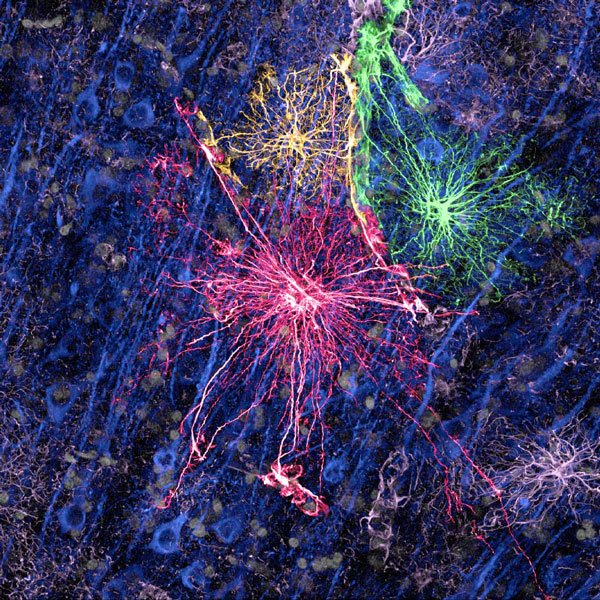
by Moe | Mar 1, 2024 | Alchemy, Brain, Science
In the human body, adenosine triphosphate (ATP) is the primary energy currency for humans cells and also all living organisms from fungi to bacteria to plants and animals. Understanding the intricate role of ATP in cellular processes is crucial for comprehending the intricate mechanisms that drive life at a microscopic level.
ATP is classified as a nucleic acid and is composed of three fundamental components: adenine, a nitrogenous base; a five-carbon ribose sugar; and a triphosphate chain containing three phosphate groups.
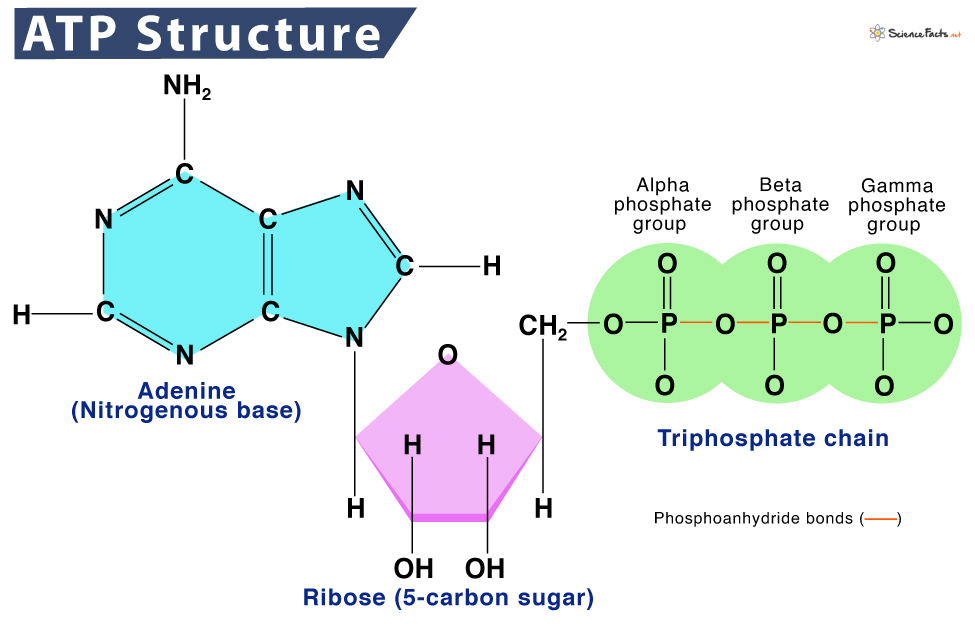
The phosphate groups in ATP, known as alpha, beta, and gamma from closest to farthest from the ribose sugar, are linked by high-energy phosphoanhydride bonds.
Its structure, with high-energy phosphate bonds, allows for the storage and release of energy, which is the driving force behind the functionality of ATP. Upon the cleavage of these bonds, a surge of energy is released, propelling a myriad of cellular functions essential for the sustenance of living organisms.
When these bonds are broken, the release of energy fuels a myriad of cellular functions, enabling processes such as muscle contraction, nerve impulse transmission, and biosynthesis to occur efficiently.
Phosphates are complex compounds fundamental to all cells and help form and repair our DNA and RNA. Phosphate is an anion composed of phosphorous (P) and oxygen (O) atoms.
Phosphorous is an element whereas phosphate is an anion.
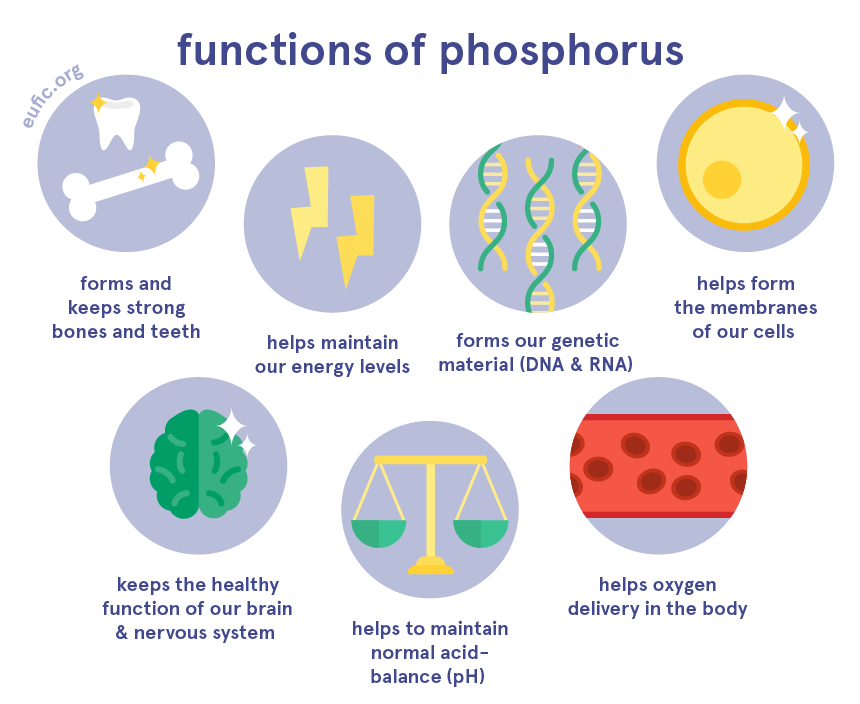
An anion is an ion with negative charge, meaning it has more electrons than protons.
It is important that we understand that all life on earth shares the elemental energy source of phosphorous. It is derived from Ancient Greek φωσφόρος (phōsphóros, “the bearer of light”), from φῶς (phôs, “light”) + φέρω (phérō, “to bear, carry”). In Latin, it is known as lucifer and is encoded in Scripture in the Book of Issah as “fallen from heavan.”
When a cell requires energy to carry out essential processes such as muscle contraction, active transport of molecules across membranes, or synthesis of macromolecules, it initiates the breakdown of ATP. Enzymes within the cell catalyze the hydrolysis of ATP by breaking the bond between the terminal phosphate group and the rest of the molecule.
This process results in the formation of adenosine diphosphate (ADP) and inorganic phosphate (Pi), along with the release of energy that was stored in the phosphoanhydride bond. The energy released powers the specific cellular activity that required it, allowing cells to perform tasks vital for their survival and function.
ATP is also known as a purine, which means it is one of two chemical compounds that cells use to make the building blocks of DNA and RNA. They are found in mainly in meat and meat products and are broken down by the body to form uric acid, which is passed in the urine.
Purines such as ATP and adenosine play a central role in the energy metabolism of all life forms. They are released from neurons and glial cells which produce widespread effects on multiple organ systems by binding to purinergic receptors located on the cell surface.
ATP is essential for various cellular processes, including brain function, muscle contraction, biosynthesis, and active transport processes in cells. Active transport involves the movement of molecules or ions against their concentration gradient, requiring energy input. It acts as an excitatory neurotransmitter in motor neurons of the spinal cord, as well as sensory and autonomic ganglia.
Through the cleavage of these phosphoanhydride bonds, ATP releases the energy needed to drive processes such as muscle contraction, nerve impulse transmission, protein synthesis, and various biochemical reactions within cells. This energy transfer mechanism not only sustains basic cellular functions but also enables organisms to grow, reproduce, and respond to environmental stimuli.
When this system is altered or is not getting and or recycyling an adequate amount of ATP through diet and excercise, then these processes become corrupt causing orgamisms such as humans to stop growing and able to respond adequately to environmental stimuli.
I contend that you physical and mental capacities enter into an automanous or sleep like state.
HOW DO WE CREATE ATP?
ATP is created when we eat food. Especially meat and dairy products.
When food is consumed, it undergoes digestion by our microbiome, i.e.: fungi and bacteria which we feed to break down our food into vitamins and ATP energy.
Without this community of microbes that lives symbiotically within and around us, we would not be able to break down the food we eat. Hence, we would simply not exist.
My contention is that this relationship can be compared to a master and slave being that we are slaves and they are our masters.
This is why they can become paraistic when we do not give these microbes the nutrients they require. As if there is an automantonus kill switch withit our cells that turns on when we digress againts these natursal laws. Instead of eating the good food we supply them with, they will eat us and the science proves this.
Let me explain how this happens…
ATP synthesis is the process by which ATP is produced, typically occurring in the mitochondria of eukaryotic cells through cellular respiration by our microbiome. During this process, energy is generated and stored in the form of ATP, ready to be used for various cellular functions.
With that said, it is not you and I who create this energy, but the fungi and bacteria within our guts.
This microbial energy is created by what scientists call, “ATP synthase.”
This means our microbiome rotates in a clockwise manner (like hydroelectric turbines) in response to eating food causing proton flow coupled with ATP synthesis to catalyze the conversion of Adenosine diphosphate (ADP) to ATP.
Here is a computer animation of this process that occurs within a “healthy human gastrointestinal tract.”
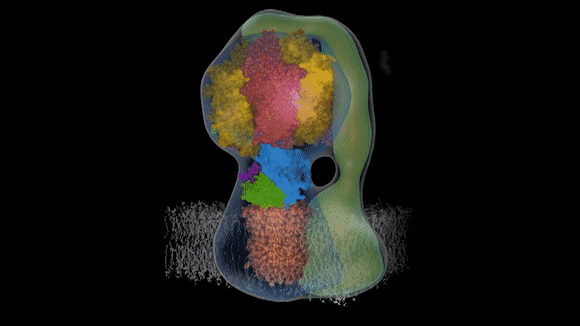
This quote from a team of scientists from Germany and Japan to summarize their study of ATP synthase:
“ATP synthase is an iconic intelligently designed molecular machine because of its rotary engine and its universal distribution. Similar forms of these rotating machines, one-tenth the size of the famous bacterial flagellum, are found in all animal cells, plant cells, bacteria, and archaea.
The precision machine raises a huge challenge to all origin-of-life theories: how could a working cell arise without these irreducibly complex molecular machines?
They are vital to every organism on earth.
I heard a biologist at JPL say that if they stopped working, we would be dead before we hit the floor.
For eukaryotic ATP synthase, there is a rotor and stator in the FO domain that turns a “crankshaft” to operate the F1 domain. In the F1 domain, three pairs of catalytic units combine ADP (adenosine diphosphate) with phosphate to produce ATP (adenosine triphosphate), the universal energy currency for most cellular processes.
A main purpose of the food we eat is to create a flow of ions to operate these machines.
ATP synthase is the last machine in a series of complexes in our mitochondria whose collective function is to donate electrons to various intermediates so that protons can be extracted. Protons accumulate between the mitochondrial membranes and flow into ATP synthases.
The machines are lined up in pairs along the folds of the mitochondria (cristae) to take advantage of the proton motive force. That flow of protons turns the FO domains like waterwheels, generating three ATP per revolution in the F1 domains, as shown in the animation.”
ADP can be converted back to ATP through a process called phosphorylation, in which a phosphate group is added back to the molecule using energy from other cellular processes such as respiration or photosynthesis.
Phosphorylation is the process by which protons move through the ATP synthase releasing energy that causes the rotor and rod of the ATP synthase to rotate. The mechanical energy from this rotation is converted into chemical energy as phosphate is added to ADP to form ATP.
The release of one or two phosphate groups from ATP, a process called dephosphorylation, releases energy, i.e., the removal of a phosphate group from an organic compound changing ATP to ADP.
Respiration is the act of respiring, which is the process by which a living organism or cell takes (inhales) oxygen from the air or water and exhales it. Photosynthesis is the process by which animals and plants use sunlight, water, and carbon dioxide to create oxygen and energy in the form of sugar.
This is exactly why today many health practitioners and coaches highly recommend people breathe properly to get proper oxygen intake and go out into the sun as often as possible.
The main purpose is to keep our cells oscillating/rotating in a clockwise manner with the clock of the earth (circadian rhythms) through environmental cues and managing bodily processes by consciously being aware and controlling them to a certain degree.
It is interesting to note that our microbiome creates and is in control of these natural rotations or oscillations in our gastrointestinal tracts.
I contend that this rotation does not only occur within our GI tracts, but also around our bodies as a type of signaling molecule for these same said microbes.
Scientisists call this the “purine signaling pathway.”
A purine is an aromatic ring of atoms composed of carbon and nitrogen. The main purinergic receptors are adenosine, ATP and UTP and purines include adenine and guanine, which participate in DNA and RNA formation
Purines are aromatic which means they have an aroma or smell.
This is why the human microbiome, comprising trillions of microorganisms residing in our gut, skin, and other body surfaces, plays a crucial role in not only maintaining our overall health and well-being, but also the way we smell and our bodily wastes smell.
This smell, I theorize, has a certain wavelength that signals or magnetizes these microorganisms to either live symbiotically within and around us or to command them to parasite/eat.
This is why when our ATP intake is low, fungal overgrowth will start to occur within our bodies.
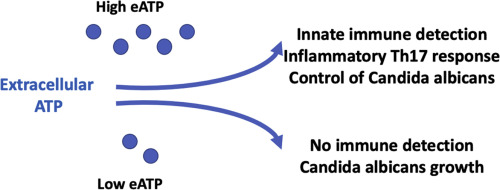
This “purine signal” I theorize acts like a magnet or computer program that sends out wavelengths based on its energy production or lack thereof. Since fungi do not have eyes, ears and a nose, these wavelengths serve as biological commands in our environments for these microorganisms such as the fungi Candida and Aspergillus to either live mutually or symbiotically or for this relationship to become parasitic.
As within, so without and as without, so within.
According to a recent study:
The skin is colonized by a diverse microbiota. Many cutaneous organisms produce molecules that regulate colonization by other microorganisms and modify their intrinsic biology and behavior. The community of commensal species can act synergistically to alter local immune reactivity for mutual benefits of the commensals and the host without leading to pathology.
As part of a dynamic equilibrium between proinflammatory and immunoregulatory signals, extracellular adenosine (ADO) triphosphate (eATP) produced by commensal flora plays an important role in the regulation of immune detection, immune response, and ultimately a balance between host and commensal organisms such as Candida albicans (Mascanfroni et al., 2015).
The term “glia,” originating from the Greek word for “glue” because it is our glia cells that act as a type of super glue or more appropriately a carbon film like matrix that create an interface with oustide stimuli and organisms.
Glial cells play pivotal roles in the intricate functioning of the brain. Beyond their traditional perception as mere “glue” cells, glial cells play a crucial role in modulating the speed and efficiency of nerve signal transmission in maintaining the brain’s homeostasis and functionality.
One of the key functions of glial cells is their role in regulating the ionic environment surrounding nerve cells. By maintaining precise levels of ions such as potassium and calcium, glial cells create an optimal milieu for efficient signal propagation. This fine-tuned control helps ensure the rapid and accurate transmission of electrical impulses along neural circuits, ultimately contributing to the proper functioning of the brain.
Moreover, glial cells contribute significantly to the speed and efficiency of nerve signal transmission playing a crucial role in modulating synaptic activity by regulating the uptake of neurotransmitters. This function allows for precise control of neuronal communication, impacting various cognitive processes and behaviors.
Astrocytes, a prominent subtype of glial cells, play a crucial role in synaptogenesis and synaptic pruning, processes essential for refining neuronal connectivity and optimizing neural circuitry. By regulating neurotransmitter levels and providing metabolic support to neurons, astrocytes fine-tune synaptic transmission and facilitate efficient neuronal communication.
In 1994, researchers conducted experiments where they stimulated astrocytes in a dish, observing nearby neurons preparing to send signals in response. Building upon this, in 1997, Volterra and his team observed rat astrocytes responding to neurons with oscillating waves of the signaling molecule calcium.
Over the span of 2000 to 2012, more than 100 papers were published supporting the notion of astrocytes communicating via synapses.
While neurons are commonly depicted as trees with branching dendrites, astrocytes resemble a fungus, creating a dense network that covers the brain and facilitates information exchange among its components.

Neurofilament staining of human astrocytes
This intricate web of astrocytes appears to play a role in influencing neuronal activity. Further research unveiled fascinating insights into astrocytes’ impact on brain function.
For instance, in 2016, Kira Poskanzer’s work at the University of California, San Francisco revealed that mouse astrocytes can induce neighboring neurons into a rhythmic sleep state, highlighting the dynamic interplay between astrocytes and neurons in shaping brain activity.
According to UCLA:
Astrocytes have been implicated in a range of neurological and psychiatric disorders, including Alzheimer’s disease, Parkinson’s disease, epilepsy, stroke, traumatic brain injury and autism. Certain aspect of astrocyte function helps neural repair whereas astrocyte dysfunction exacerbates diseases. Scientists are only beginning to understand what roles astrocytes play in each type of brain disorder.”
Astrocytes are adept at controlling the concentration of ions in the extracellular space, which is essential for maintaining the resting membrane potential of neurons. By regulating the levels of ions, glial cells help in preventing excessive neuronal excitability or inhibition, thus contributing to the stability of neural signaling.
The discovery of astrocytes in 1865 marked a turning point, leading scientists to delve deeper into the world of glial cells and uncover a vast array of functions that go beyond mere structural support. From regulating the ionic environment surrounding nerve cells to influencing nerve signal transmission speed, controlling neurotransmitter uptake, and aiding in neural development through scaffold provision, glial cells have proven to be indispensable players in the neural orchestra.
This newfound understanding challenges the traditional notion of glial cells as passive bystanders and underscores their active and crucial involvement in brain physiology.
CONTROL YOUR GUT (MICROBIOME) OR IT WILL CONTROL YOU!
Our microbiome influences our digestion, metabolism, immune system, and even mental health. It aids in the breakdown of food, the synthesis of essential nutrients, and the protection against harmful pathogens.
These tiny inhabitants consist of bacteria, viruses, fungi, and other microorganisms that form a complex ecosystem within and AROUND us.
This intricate network of microbes communicates with our cells and influences gene expression, demonstrating its profound impact on our physiology.
This symbiotic and sometimes parasitic relationship between our microbiome and energy production pathways underscores the interconnectedness of our body’s systems and the profound impact it can have on our overall well-being.
Meaning exercise and movement, which causes our cells to respire and going the sun are important for this process to work correctly.
Regulation and Recycling of ATP in Living Organisms
Regulation and recycling of ATP in living organisms are vital processes that ensure the continuous availability of energy necessary for cellular activities. The intricate balance of ATP levels within cells is tightly regulated to meet the dynamic energy demands of various biological processes.
Cells possess sophisticated mechanisms to maintain optimal ATP levels. One crucial aspect of ATP regulation involves the enzymes responsible for ATP synthesis and degradation. ATP synthase, a key enzyme in cellular respiration, facilitates the production of ATP from adenosine diphosphate (ADP) and inorganic phosphate (Pi) during the process of oxidative phosphorylation.
Conversely, ATPases are enzymes that catalyze the hydrolysis of ATP to ADP and Pi, releasing energy that fuels cellular processes. ATP Hydrolysis is a chemical reaction where a phosphate bond that has been stored within ATP is broken by water after splitting these bonds, for example in muscles, by producing work in the form of mechanical energy.
When it comes to ATP production, understanding the differences between aerobic and anaerobic respiration pathways is crucial.
Aerobic respiration is the process that occurs in the presence of oxygen and is highly efficient, producing a large amount of ATP from glucose molecules. This process takes place in the mitochondria of cells and involves a series of complex reactions, including the citric acid cycle and oxidative phosphorylation.
On the other hand, anaerobic respiration occurs in the absence of oxygen and is less efficient compared to aerobic respiration. One common example of anaerobic respiration is fermentation, where glucose is partially broken down to produce ATP and byproducts such as lactic acid or ethanol fermentation. I
While anaerobic respiration can provide a quick burst of energy, it is not sustainable for long periods due to the accumulation of lactic acid which can lead to muscle fatigue.
ATP’s function is entirely reliant on the availability of ADP. Without an adequate supply, ATP synthase ceases to function correctly, causing it to dysfunction and decreased ATP production.
Meaning, at the cellular level, your cells start to stop spinning and producing energy.
In fact, it can start spinning counter clockwise.
This then rewires energy metabolism and causes enhanced glycolysis and inflammatory processes, which are a common feature of many age‐associated diseases, including Alzheimer’s, muscular dystrophy, ALS, diabetes and cancer.
This is called microbiota dysbiosis, which refers to an imbalance in the composition and function of the microbial communities that reside in our gut.
The meaning of the compound word dysbiosis is from the Greek dys which means bad and biosis, the way of life.
Dysbiosis has been linked to conditions such as irritable bowel syndrome (IBS), inflammatory bowel disease (IBD), small intestinal bacterial overgrowth (SIBO), depression, anxiety, and autism spectrum disorders.
Intestinal epithelial cells (IECs) sense microbial stimuli through a number of different mechanisms that regulate IEC gene transcription and inflammatory responses.
It plays an important role in the digestion of food, absorption of nutrients, and protection of the human body from microbial infections, and others.
The intestinal epithelium is a highly dynamic tissue that provides both physical and chemical barriers to protect the intestinal mucosa and peripheral organs from commensal microbes or invading pathogenic microorganisms. In addition to forming a barrier, IECs also detect a myriad of signals from intestinal microbes, allowing fine tuning of IEC proliferation and homeostatic functions
It is the interface between us and them.
A deficiency in ATP synthase, believed to be triggered by mutations in the mtDNA genes for ATP subunits, contributes to various genetic mitochondrial diseases. Moreover, a range of conditions, including Alzheimer’s, muscular dystrophy, ALS, diabetes, and cancer, can induce secondary mitochondrial dysfunction.
Unfortunately, there are currently no known treatments for either secondary ATP deficiency or genetic mitochondrial diseases. However, researchers at the University of Colorado (CU) have been delving into the symbiotic relationship between gut bacteria and the human body, potentially uncovering a breakthrough for addressing ATP synthase deficiency.
They have devised a method to circumvent this limitation by leveraging fast-growing filamentous fungi, Neurospora crassa.
Neurospora crassa is a type of red bread mold of the genus of Ascomycete. The name, meaning ‘nerve spore’ in Greek, refers to resemblance to brain axons.
Neurospora research has found this fungi to be especially useful for studies of photobiology, circadian rhythms, population biology, morphogenesis, mitochondrial import, DNA repair and recombination, DNA methylation, and other epigenetic processes (Borkovich et al. 2004).
To be continued…
SOURCES:
Science Facts
Science Direct
Chemisty World
Colorado University
UCLA
University of Copenhagen
Univesity of Colorado
Moe is the founder of GnosticWarrior.com. He is a father, husband, author, martial arts black belt, and an expert in Gnosticism, the occult, and esotericism.

by Moe | Jan 31, 2024 | Meaning of Symbols, Meaning of Words, Philosophy
Since ancient times, many philosophers, mathematicians, and theologians have said that the monad or number one represents a secret principle of a sacred central fire that unites all things forming our realities.

This concept has a profound significance in both philosophy and cosmogony for well over 2,000 years.
The Greeks called it the “monad or monas,” meaning “unity” or “oneness,” which represents the fundamental building block of existence. It was associated with the belief in the “prime mover” or the first cause that set the universe in motion.
This concept can be traced back to the teachings of ancient philosophers such as Pythagoras and Plato, who believed in the existence of a fundamental substance that underlies the diversity of the material world.
According to Pythagoras, who some consider the Father of Math and his followers, the Pythagoreans, the monad is the ultimate source of all existence.
In this philosophy, the number one or monad is considered the origin of numbers, as numbers are seen as the building blocks of reality. It stood at the pinnacle of this numerical hierarchy.
For the Pythagoreans, the Monad represented the source from which all other numbers and mathematical relationships were derived.
It symbolized unity, indivisibility, and the essence of all beings.
ORDO AB CHAO
The monad is seen as the creative force, fire or energenetic force that brings order out of chaos, giving rise to the intricate web of interconnectedness that defines our reality. It is the principle that brings about the principles of symmetry, proportion, and harmony that permeate the natural world.
In Pythagorean cosmogony, it serves as the guiding force that organizes or more appropriately, magnetizes the chaotic elements of the universe into a harmonious order. According to their teachings, each number possessed its own unique essence and vibrational frequency, and these vibrations were considered to be the very fabric of reality.
They believed that it gave rise to the dyad, which then generated all other numbers and the material world. It is the indivisible and immutable essence that underlies the entire cosmos.
This embodies the idea that everything in the universe can be reduced to a singular, fundamental unit. In its essence, it is the ultimate unity, the indivisible entity from which all things originate. Hence, the monad represents the primary building block of reality, the seed of creation, and the spark that ignites the cosmic order.
For Plato, this force or fire was called ether and was the substance by which the Craftsmam had created the universe and world. The Freemasons represent this with their motto, ORDO AB CHAO and the concept of the Great Architect of the Universe (T.G.A.O.T.U.).
This concept of the monad is often depicted as a circle, symbolizing its perfect and infinite nature.

THE MONAD IN ESOTERIC PHILOSOPHY
In the realm of ancient and esoteric philosophies, the concept of the Monad holds a significant place in Gnosticism, Hermeticism and Alchemy. These mystical traditions, intertwined with deep spiritual wisdom, have long sought to understand the nature of existence and the interconnectedness of all things.
In Gnosticism, the monad is at the root of the pleroma, the infinite fount of matter and energy in the universe.
In Hermeticism, the Monad is seen as the ultimate source of all creation, the divine spark from which everything springs forth. It represents the timeless and indescribable essence that permeates all levels of reality. This concept aligns with the idea of the One in Neoplatonism, emphasizing the unity and oneness of the universe.
Alchemy, on the other hand, views the Monad as the primordial substance or the original matter from which the alchemical transmutation takes place. It is the raw material that undergoes various stages of refinement and purification, ultimately leading to the attainment of perfection or the Philosopher’s Stone.
It symbolizes the potential for transformation and the inherent unity of all elements.
33rd Degree Freemason and author, Manly P. Hall wrote;
“The number one was the point within the circle , and denoted the central fire , or God , because it is the beginning and ending ; the first and the last . It signified also love , concord , piety , and friendship , because it is so …”
Hall said, “The sun is a great dot, a monad of life, and each of its rays a line – its own active principle in manifestation.
The key thought is: The line is the motion of the dot. The dot, or Sacred Island, is the beginning of existence, whether that of a universe or a man.”
It is seen as the unity that precedes duality, representing the transition from the formless to the formed.

Just as the concept is a single entity, it is also considered the harmonious union of opposites. It represents the synthesis of opposites such as light and darkness, male and female, unity and multiplicity, and harmony, balance or order.
As Plato wrote, “Love is born into every human being; it calls back the halves of our original nature together; it tries to make one out of two and heal the wound of human nature.” (Plato, The Symposium)
From Plato, Neoplatonism, placed great emphasis on the concept of the Monad, particularly through the teachings of one of its prominent figures, Plotinus.
According to Plotinus, the One is beyond all categories and distinctions. It is ineffable and transcendent, beyond the grasp of human comprehension. It is the origin and cause of all things, the pure essence from which everything else derives its being.
Plotinus taught that through contemplation and philosophical inquiry, individuals can come to realize their connection to the One and experience a sense of oneness with the ultimate reality.
In Neoplatonic philosophy, the journey towards understanding the One, or the Monad, is seen as a spiritual ascent. This journey involves transcending the limitations of the material world and ascending through the various levels of existence, ultimately reaching a state of unity with the One.
This realization brings about a transformative spiritual awakening, leading to a higher understanding of the self and the universe.
THE MONAD IN EASTERN PHILOSOPHY
In Chinese philosophy, the concept of the monad is reflected in the teachings of Taoism, where it represents the ultimate source of all things. Taoism, rooted in the profound wisdom of Lao Tzu’s Tao Te Ching, delves into the fundamental principles of existence and the interconnectedness of all things.
At the heart of Taoist philosophy lies the concept of the Tao, often described as the “Way” or the “Ultimate Reality.”
It is the underlying force that governs the universe, encompassing both the seen and unseen aspects of existence representing the unifying essence that flows through all things, connecting them in a harmonious and ever-evolving dance.
According to Taoist teachings, it is the eternal and unchanging essence that transcends the duality of existence, encompassing both yin and yang, darkness and light, movement and stillness.
The Taoist sages emphasize the importance of aligning oneself with the flow of the monad, harmonizing with its rhythms and embracing the natural order of the universe.
It was also explored in Indian philosophy, particularly in the school of Hindu philosophy known as Advaita Vedanta. Here, the monad, referred to as “Atman,” is considered the eternal, unchanging essence of the self, which is indistinguishable from the ultimate reality, known as “Brahman.”
This idea of the monad was incorporated within monotheism, and the monotheistic religions symbolized as God or the universe.
It served as a metaphorical representation of the divine spark present within every individual. The Monad was seen as the innermost essence of the human soul, connecting each individual to the universal cosmic order.
It embodied the idea that each person possessed a unique and irreplaceable role within the grand tapestry of existence.
Hence, One God. One Lord. One Faith and One Baptism by Holy Fire (monad) – Not water.
To reunite with the One of God was to be Born Again.
The Prodigal son who was lost is now found.
THE MONAD IN MODERN SCIENCE
In the field of science, the notion of a unified theory that explains the fundamental workings of the universe has been a longstanding pursuit.
From the Ancient Pythagoreans and Plato to Leibniz’s monadology and modern science and philosophy, the concept of the monad has provided the unifying framework for the theory of relativity to quantum mechanics, understanding consciousness, free will, and the nature of reality itself.
In the 17th century, German philosopher and mathematician Gottfried Wilhelm Leibniz revived the concept of the monad. His magnum opus, “Monadology,” provides profound insights into the nature of reality, metaphysics, and the interconnectedness of all things.
In “Monadology,” Leibniz presents a metaphysical framework that explains the nature of existence and how monads relate to one another. He argues that they do not directly interact but rather harmoniously coexist in a pre-established harmony, orchestrated by a divine entity.
Leibniz’s modern concept of monadology challenges the traditional understanding of causality and suggests a synchronized universe where every monad’s actions align with the actions of other monads, creating a grand cosmic dance.
Influenced by his studies in mathematics and metaphysics, Leibniz proposed that monads were the basic units of reality, each possessing its own unique properties and experiences. He said they were indivisible and could not be influenced by external forces, but rather, they interacted with one another through a pre-established harmony.
According to Leibniz, they are indivisible, immaterial substances that are the fundamental building blocks of the universe.
Each is unique, representing a distinct perspective on reality.
These monads are not passive entities but rather possess inherent qualities and capacities that allow them to perceive, act, and interact with other monads.
He suggests that each one possesses a unique perception of the universe, which he calls “apperception.”
This individualistic perspective shapes the experiences and consciousness of each monad, making them active participants in the construction of reality. Hence, each individual substance is seen as a unique monad with its own perception and consciousness that are co-creators or builders of the world in which we live.
Epistemologically, Leibniz’s monads provide a unique perspective on the nature of knowledge or Gnosis.
Since each monad is a separate and distinct microcosm of the universe, it possesses its own unique perspective and experiences. This notion of “pre-established harmony” suggests that each monad has access to a specific set of truths, forming the basis of its individual knowledge.
Hence, no two humans are exactly the same.
Furthermore, Leibniz proposes that they are not confined to the physical realm but also exist in the realm of immaterial substances. This duality allows for a deeper exploration of the connection between mind and matter, challenging the Cartesian mind-body dualism prevalent during his time.
In the realm of physics, the concept of the Monad resonates with the fundamental building blocks of the universe. In particle physics, for instance, the notion of elementary particles can be seen as analogous to monads.
These indivisible units, such as quarks or electrons, possess unique properties and interact with one another to form the complexity we observe in the physical world.
In biology, the concept can be related to the idea of the cell as the fundamental unit of life. Just as monads are self-contained entities, cells possess their own internal structures and functions, while simultaneously interacting with other cells to compose the complex organisms we observe.
Moreover, the concept of the Monad has also sparked intriguing discussions in fields such as psychology and consciousness studies. Some theorists propose that the monad can be associated with the individual consciousness, representing a unique and self-contained center of experience within each person.
Additionally, the concept of monads has found resonance in cosmogony, the study of the origin and evolution of the universe. They are seen as the primordial entities that give rise to the diversity and complexity of the cosmos.
Monads represent the underlying fabric from which everything emerges and are seen as the driving force behind the dynamic unfolding of the universe.
In the realm of mathematics and computer science, the concept of the Monad has found its home in the paradigm of functional programming. Functional programming is an approach to software development that emphasizes the use of pure functions and immutable data.
In functional programming, a monad represents a computational context or a sequence of computations. In functional programming, it provides a clear separation between pure computations and impure actions, promoting code that is easier to reason about and test.
It allows developers to encapsulate side effects, such as reading from or writing to a database, handling exceptions, or dealing with I/O operations, within a controlled and composable structure. This enforces an explicit and disciplined mathematical approach to handling effects, ensuring that their impact is predictable and managed within the confines of the Monad.
At the core of the Monad in functional programming lies the bind operation, often represented by the symbol “>>=”, which allows sequential composition of computations within the Monad. This enables developers to chain together a series of operations, each dependent on the result of the previous one, without explicitly dealing with the underlying data transformations or side effects.
Hence, ALL IS MATH.
By leveraging the Monad, functional programmers can write code that is concise, modular, and reusable, which simplifies complex operations and promotes a declarative style of programming. It enables them to leverage the principles of functional programming to write elegant and efficient code, while also appreciating the historical and philosophical roots of this powerful concept.
Today we can see this in real time with social media platforms like X, Facebook and Instagram that are monotheistic hosts to billions of people, each living in their own multipolar worlds.
Worlds that are not defined by biological traits, genetics, and common characteristics, but by various degrees and categories of knowledge, ideas and wisdom or a lack thereof.
Let me remind you that in modern monadology, monads are individualistically magnetic and like attracts like.
This is why in the monotheistic religion of Christianity, the great teacher Jesus said;
“My people are destroyed for lack of knowledge: because thou hast rejected knowledge, I will also reject thee, that thou shalt be no priest to me: seeing thou hast forgotten the law of thy God, I will also forget thy children.” – Hosea 4:6
CONCLUSION
In conclusion, the significance of monads in modern philosophy lies in their role as fundamental entities that shape our understanding of existence, consciousness, and the interconnected nature of reality.
It invites us to question the nature of the world as we contemplate the interplay between unity and multiplicity, and delve into the depths of our own existence.
As we embark on this monadic journey, we open ourselves to new insights and perspectives that can enrich our understanding of the profound mysteries within the cosmic tapestry (filamental web) that surrounds us.
Moe is the founder of GnosticWarrior.com. He is a father, husband, author, martial arts black belt, and an expert in Gnosticism, the occult, and esotericism.
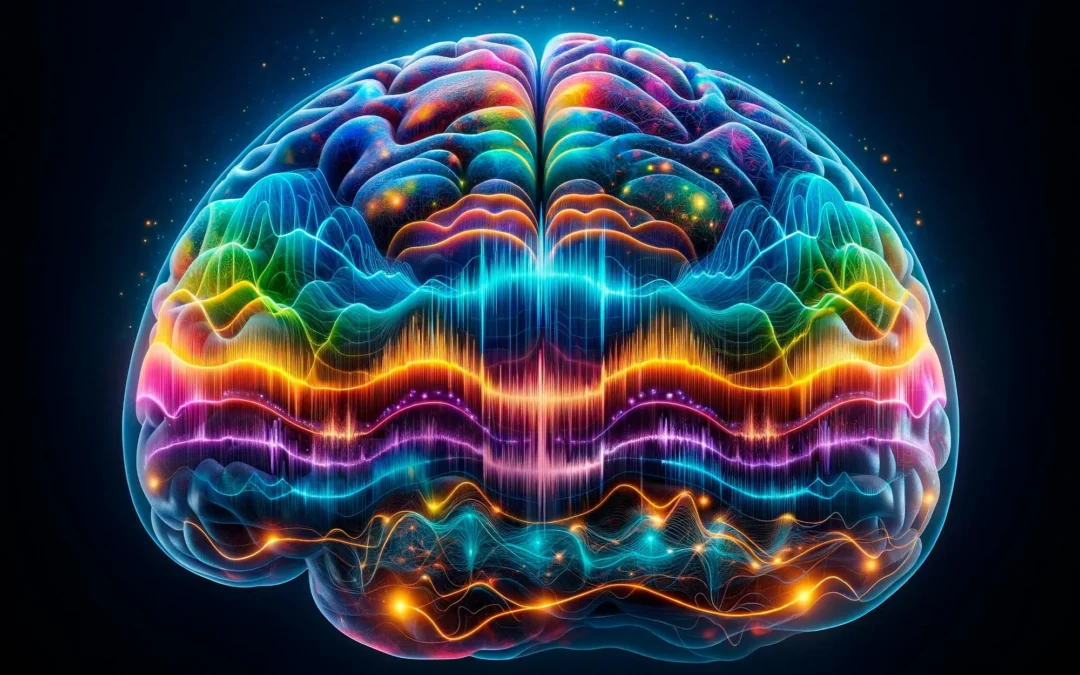
by Moe | Jan 23, 2024 | Brain, Mind Control Research, Philosophy
Brain waves, also known as brain rhythms or oscillations, emerge from the synchronized network of electrical activity of neurons in our brains. These coordinated efforts facilitate crucial functions like perception, cognition, and intelligence.
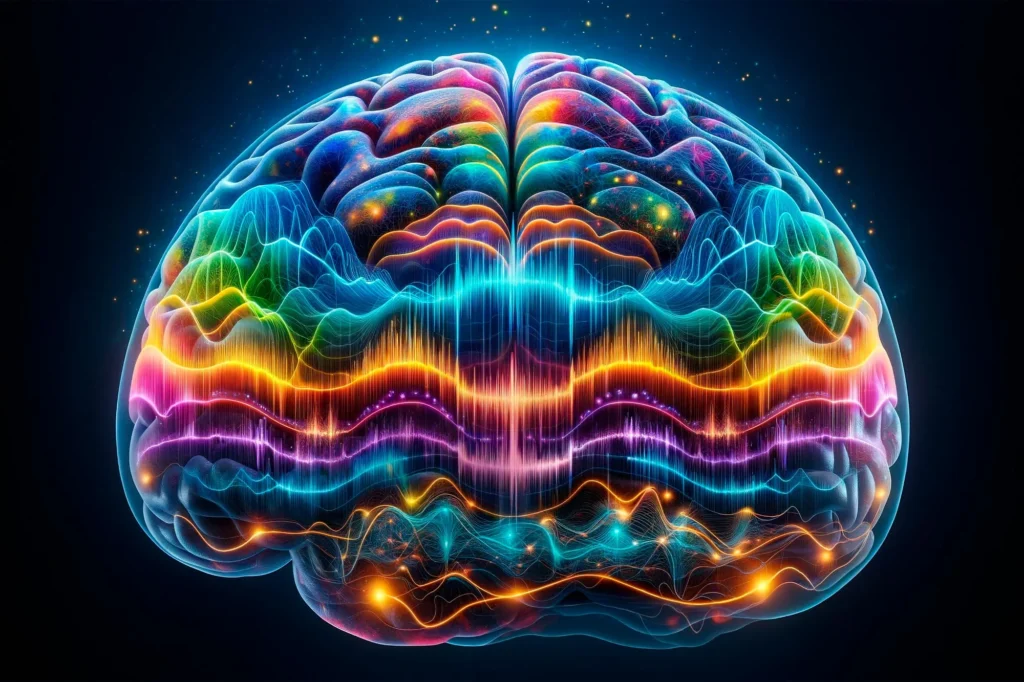
From our thoughts and emotions to our behavior and learning abilities, brain wave patterns play a crucial role in shaping who we are as individuals. In fact, studies have shown they hold the key to understanding the intricacies of human uniqueness.
The latest neuroscience research has found that our brains operate on differing frequencies, each associated with different states of consciousness and intelligent functions. What it shows is that each of us has differing brain wave activity that is directly related to our genetics and learning capabilities which equates to our overall intelligence and IQ.
Hence, your ability to truly think and your intelligence can now be measured and categorized into different frequencies, each associated with specific mental states and cognitive processes. Therefore, understanding the different types of brain waves is a fascinating and essential aspect of unraveling the mystery of how they define our uniqueness.
Scientists are able to assess human intelligence and mental illness with a special machine called an electroencephalogram (EEG). During an EEG, electrodes are placed on the scalp to detect and record brain waves, which are rhythmic oscillations of electrical activity that occur in different regions of the brain.
These electrodes pick up the different frequencies and amplitudes of the brain waves starting at the low delta (<4 Hz), theta (4–8 Hz), alpha (8–12 Hz), and higher frequencies such as beta (12-30 Hz), gamma (30–80 Hz), and high gamma (>80 Hz). The recorded data is then analyzed to identify the various types of waves and their patterns.
The unique combination and interplay of these brain wave patterns contribute to our individual uniqueness.
Just as no two fingerprints are exactly alike, no two individuals have the same brain wave patterns. These patterns shape our cognitive abilities, personality traits, and even our responses to external stimuli.
Research has shown that each of these waves corresponds to specific mental states and activities, offering insights into our cognitive processes and overall brain functioning.
For example, beta waves, which have a high frequency, are linked to focused attention, problem-solving, and critical thinking.
Alpha waves, with a lower frequency just under beta, are associated with a relaxed state of mind, creativity, and insight.
However, the highest cognitive functions in humans are measured via gamma waves, the fastest and highest frequency brain waves, which are linked to heightened cognitive functioning, attention, and memory.
These waves are believed to play a crucial role in learning and information processing, allowing us to absorb and retain new knowledge effectively.
But when it comes to people whose brains are not functioning properly or due to mental illness, they operate in the theta and delta range.
Slow wave activity is composed of both large amplitude and low frequency activity in the delta (0.5–4 Hz) or theta (4–7 Hz) frequency bands is normally only seen in people while they are sleeping, but it is also observed in people with mental illness.
Delta and theta activity in the waking state has mainly been studied in people with neurological disorders, but abnormal slow brain waves are found in many developmental and degenerative disorders, and also in several other neurological conditions.
Delta waves, characterized by low-frequency and high-amplitude patterns, are associated with deep sleep and unconsciousness. These waves are crucial for restorative sleep, allowing our bodies to rejuvenate and recharge during the night as we repair our bodily tissues, and strengthen the immune system.
This technology is being further developed by various governments for biometric security in the form of finger and palm prints, iris scanning, facial recognition, and blood, vein and cognitive pattern recognition.
The Four Types of Biometric Security are:
Biological biometrics
Morphological biometrics
Behavioral biometrics
Cognitive biometrics
Cognitive biometric security measures brainwave patterns, also known as brainprints, which are considered a superior biometric alternative by researchers when compared to fingerprints or retinal scans.
This is a novel approach to user authentication and/or identification that utilizes the response(s) of nervous tissue in response to one or more stimuli, and the subsequent response(s) are acquired and used for authentication.
Cognitive biometrics use bio-signals that are measured via a EEG-based BCI system for authenticating a person is primarily derived from the unique subtle features embedded in them (Revett and de Magalhães, 2010; Gupta et al., 2012).
Unlike fingerprints or retinas, which are static once compromised, a brainwave pattern offers the advantage of being changeable, enabling users to reset it if their brain print is stolen.
One of the key advantages of the brainprint is its non-invasive nature.
Unlike traditional biometric methods that rely on physical features like fingerprints or facial recognition, a brainprint does not require any direct contact with individuals.
This makes it convenient, user-friendly, and less susceptible to privacy concerns. Individuals can be recognized simply by analyzing their unique brain activity patterns, without the need for physical interaction.
Moreover, the complexity of brain patterns makes it extremely difficult for potential attackers to forge or replicate brainprints. The intricate network of neural connections and individual brain signatures add an extra layer of security to the system.
This resistance to attacks enhances the robustness and reliability of brainprint as a biometric recognition technology.
A 2016 study from Binghamton University used cognitive biometrics to identify a group of 50 participants with 100 percent accuracy. Previous research published in 2015 successfully identified individuals with 97 percent accuracy.
The significant improvement from 97 percent last year to a perfect 100 percent this year is particularly crucial for high-security environments like the Pentagon, necessitating flawless detection and authorization systems.
As neuroimaging and hidden biometric modalities continue to evolve, the brainprint emerges as a compelling alternative for person recognition.
Unraveling the mystery of how brain wave patterns define our uniqueness opens up a world of possibilities for harnessing our cognitive abilities to their fullest potential.
It highlights the intricate interplay between our brains and our individual cognitive strengths, providing a deeper understanding of what makes each of us truly unique.
SOURCES:
EEE Transactions on Information Forensics and Security
Using brain prints as new biometric feature for human recognition
Digital Trends
Moe is the founder of GnosticWarrior.com. He is a father, husband, author, martial arts black belt, and an expert in Gnosticism, the occult, and esotericism.

by Moe | Jan 16, 2024 | Apocalypse, Mind Control Research, Science
On Thursday, Florida Surgeon General Dr. Joseph Ladapo went on the Steve Bannon War Room Podcast calling the COVID-19 vaccine inoculations – the “Antichrist of all products”
Lapado brought the conversation about vaccines into the religious dimension with his criticism as if it were the mark of the beast.
“I think it probably does have some integration at some levels with the human genome,” Ladapo said, “because these vaccines are honestly—they’re the Antichrist of all products.
Tucker Carlson interviewed the Florida Surgeon General on January 15th about his statements.
So I think it probably does. But I’m not saying it does.
“I’m saying that they themselves have said you should test for it,” he said of the U.S.Food and Drug Administration.
“And that hasn’t happened, and they’ve provided no proof that it’s happened. And that’s so wrong.
You know, it’s just complete disrespect to the human genome and the importance of protecting it and preserving it.
And that is our connection to God.”
Florida Surgeon General Ladapo’s comments come on the heels of the Ron DeSantis appointee who advocated for the discontinuation of mRNA vaccines, citing his belief that they could pose a threat to DNA.
In a statement released January 4th by the Florida Department of Health, Ladapo referred to a Dec. 6 letter to the FDA in which he raised concerns about “nucleic acid contaminants” in the Pfizer and Moderna COVID-19 mRNA vaccines, and the “unique risks posed by DNA integration.”
The U.S. Food and Drug Administration called Ladapo’s DNA claims “misleading” and “implausible,” saying they have proven to be safe, effective and often life saving.
“The FDA stands firmly behind the safety, effectiveness and manufacturing quality of the approved and authorized COVID-19 vaccines, and respectfully disagrees with the Florida Surgeon General’s opinion.
“It is simply a fact that millions of lives have been saved because of the COVID-19 mRNA vaccines, which most Americans undergoing vaccination have received,” said FDA spokesperson Cherie Duvall-Jones.
“The challenge we continue to face is the ongoing proliferation of misinformation and disinformation about these vaccines which results in vaccine hesitancy that lowers vaccine uptake,” the FDA response to Ladapo said.
“Given the dramatic reduction in the risk of death, hospitalization and serious illness afforded by the vaccines, lower vaccine uptake is contributing to the continued death and serious illness toll of COVID-19.”
Moe is the founder of GnosticWarrior.com. He is a father, husband, author, martial arts black belt, and an expert in Gnosticism, the occult, and esotericism.

















